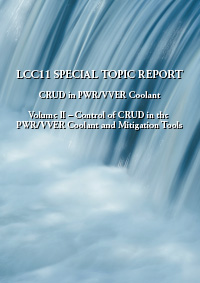
CRUD in PWR/VVER Coolant Volume II – Control of CRUD in the PWR/VVER Coolant and Mitigation Tools
(LCC11 STR)
All materials used in nuclear power plants, as bare material (steels and alloys), are not stable in the reactor water and dissolve by corrosion. They are protected by passive oxide layers formed by the corrosion attack of the water to the metal surface under operating conditions. However, to some small extent these oxide layers dissolve in the reactor coolant and are transported as corrosion products (called also CRUD) to the reactor core. There they deposit on the fuel assemblies and are activated. The deposition of the crud on fuel assemblies and their release to the coolant highly influences the core and plant performance with respect to fuel cladding integrity and radiation fields.
The purpose of the Volume II of this Report, in LCC11, is to describe the tools and their application to adequately control the coolant crud in order to improve the fuel and out-core radiation performance. This information can support the plant chemists to establish strategies of applying the mitigating tools for crud control to achieve their plant specific goals. The information given in this Report is also valuable for fuel vendors and plant fuel engineers to evaluate the possible ways of improving the fuel performance. In a similar way, this information helps the Regulators at properly examining the relative importance of various CRUD Control Mitigating Tools to ensuring an improved fuel performance for safe operation. The associated Volume I containing: Mechanism of Sources, Transportation in Coolant, Fuel Deposition and Radiation Build-up, was published within the LCC10 Programme.










